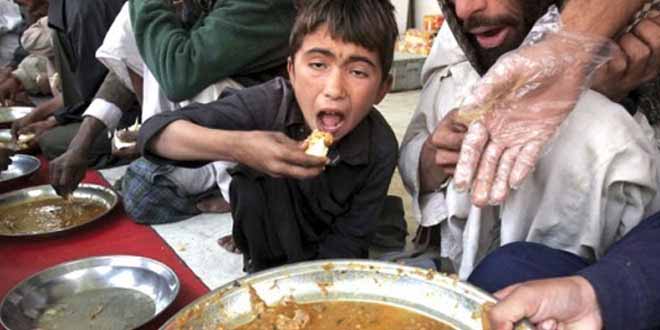
Are you malnourished?
Malnutrition is a condition which results from eating a diet in which certain nutrients are lacking. People who are malnourished may not consume adequate calories and protein for growth and maintenance. Undernutrition, another term used, results in stunting, wasting, and deficiencies of essential vitamins and minerals. Poor diet may lead to a vitamin or mineral deficiency, among other essential substances, sometimes resulting in scurvy a condition in which an individual has a vitamin C deficiency. Severe malnutrition is used to refer to Protein-Energy malnutrition (PEM), which is associated with micronutrient deficiency.
Two forms of PEM are kwashiorkor and marasmus. Kwashiorkor is mainly caused by inadequate protein intake resulting in a low concentration of amino acids. The main symptoms are edema, wasting, liver enlargement, hypoalbuminemia (levels of albumin in blood serum is low), steatosis (accumulation of fat in the liver), and depigmentation of skin and hair. Kwashiorkor is identified as swelling of the extremities and belly. Marasmus, termed “to waste away,” is caused by inadequate intake of protein and energy. The main symptoms are severe wasting, leaving little or no edema, minimal subcutaneous fat, severe muscle wasting, and non normal serum albumin levels.
Conditions are seen as extreme wasting of the muscles and a gaunt expression. Malnutrition increases the risk of infection and infectious disease, and moderate malnutrition weakens every part of the immune system. Malnutrition affects HIV transmission by increasing the risk of transmission from mother to child and also increasing replication of the virus. Lower energy and impaired function of the brain is also an effect of malnutrition as the malnourished are less able to perform tasks to acquire food, earn an income, or get an education.
Signs and symptoms of malnutrition
A symptom is something the patient feels and reports, while a sign is something other people such as a doctor detects. Signs and symptoms of malnutrition include:
- Loss of fat (adipose tissue)
- Breathing difficulties, a higher risk of respiratory failure
- Depression
- Higher risk of complications after surgery
- Higher risk of hypothermia – abnormally low body temperature
- Immune system is weakened, increasing the risk of infections
- Longer healing time for wounds
- Longer recovery from infections and illness
- Lower sex drive
- Problems with fertility
- Reduced muscle mass
- Reduced tissue mass
- Tiredness, fatigue or apathy
- Irritability
- Skin may become thin, dry, inelastic, pale and cold
- As fat in the face is lost, the cheeks look hollow and the eyes sunken
- Hair becomes dry and sparse, falling out easily
- Sometimes may lead to unresponsiveness
Children who are malnourished typically experience slow behavioral development, even mental retardation may develop. Even when treated, undernutrition may have long term effects in children, with impairments in mental function and digestive problems persisting, well into their adulthood.
Causes of malnutrition
- Poor diet – If a person does not eat enough food or if what they eat does not provide them with the nutrients they require for good health, they suffer from malnutrition. If the patient develops dysphagia (swallowing difficulties) because of an illness, they may not be able to consume enough of the right nutrients.
- Mental health problems – Some patients with mental health condition such as depression may develop eating habits which may lead to malnutrition. Patients with anorexia may develop malnutrition because they are ingesting too little food.
- Mobility problems – People may develop malnutrition because they simply don’t have the means to gather or prepare food.
- Digestive disorders and stomach conditions – Some people may eat properly, but their bodies cannot absorb the nutrients for good health. Patients who have episodes of diarrhea or vomiting may lose vital nutrients and are at higher risk of malnutrition.
- Food shortages – Food shortages is caused by a lack of technology for higher yields in modern technology such as nitrogen fertilizer, pesticides and irrigation.
- Food prices and food distribution – High food prices and problems with distribution of food results in famine
- Lack of breastfeeding – Lack of breastfeeding results in malnutrition in infants. Breast milk has all of the proper nutrients necessary to avoid malnutrition.
Treatment options for malnutrition
Aims for treatment include the treatment for any underlying condition or illness which is contributory factors to malnutrition. Typically, treatment will include a feeding program with a specially programmed diet and additional nutritional supplements. Severely malnourished patients who cannot get sufficient nutrition by eating or drinking may need and should receive artificial nutritional support. There are two main types of artificial support, enteral feeding or tube feeding in which a tube is placed through the nose, the stomach or small intestine. Parenteral feeding is the other support in which a sterile liquid is fed directly into the blood stream. A good healthcare professional will discuss eating and drinking with the patient and provide advice for healthy food choices. The doctor or dietician should work with the patient to make sure enough calories are being consumed from carbohydrates, proteins, fats and dairy.

